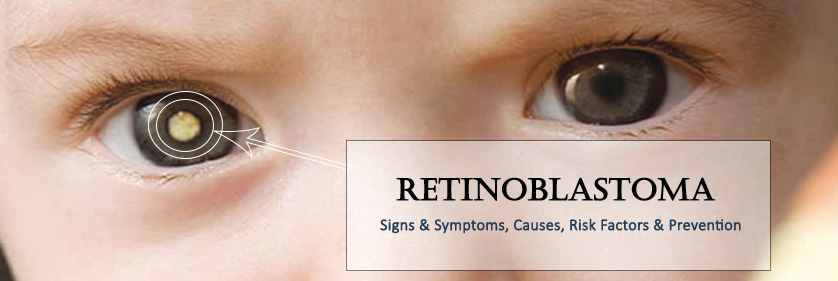What is Retinoblastoma?
This is a rare type of eye cancer usually occurring during childhood. It starts in the retina — the part of the eye that senses light and sends pictures to the brain.
Fewer than 300 children in the U.S. are diagnosed with it each year. Usually, it’s found before they turn 2.
Signs and Symptoms
Retinoblastomas nearly always occur in young children. They also appear to be noticed when a parent or doctor discovers that the eye of a child appears odd.
White pupillary reflex
This is the early sign of retinoblastoma which is most common. Normally when you shine a light in the eye, the pupil (the dark spot in the centre of the eye) appears red in the back of the eye because of the blood vessels. The pupil sometimes appears white or pink in an eye with retinoblastoma instead, which is known as a white pupillary reflex (or leukocoria).
After a flash photograph is taken, a parent might notice this white glare, especially if the pupils are different colours. This may also be noticed during a regular eye test by the child’s doctor.
Lazy eye
Often the eyes do not look in the same direction, a condition which is sometimes called a lazy eye. (Doctors call this strabismus.) There are many possible causes of this in children. Most of the time lazy eyes are caused by a mild muscle weakness which controls the eyes, but also by retinoblastoma.
Other possible signs and symptoms
Less common signs and symptoms of retinoblastoma include:
• Vision problems
• Eye pain
• Redness of white eye portion
• Bleeding to the front of the eye
• A pupil not getting smaller when exposed to bright light
• Each iris has a different colour (coloured part of the eye)
• Bulging of the eye
If cancer spreads beyond the eye, symptoms depend on the location of cancer. Some possible symptoms include:
• Loss of appetite and weight loss
• Headache
• Vomiting
• Lumps under the skin in the neck
Some of these signs and symptoms are more likely to result from anything but retinoblastoma. Still, if your child has any of these, check with your child’s doctor so the cause can be found and treated, if needed.
What causes retinoblastoma?
Retinoblastoma is a cancer of the retina. The retina is the luminescent coating on the back of the eye.
Retinal eye cells grow very quickly during the early stages of a baby’s development, and then stop growing. But in rare cases, one or more cells keep growing and forming cancer called retinoblastoma.
Retinoblastoma is caused by a defective gene in about 4 out of 10 cases (40 per cent) and also affects both eyes (bilateral). The faulty gene may be inherited from a parent, or a change to the gene (mutation) may occur at an early stage of the child’s development in the womb.
it is not clear what causes the remaining 60 per cent of cases of retinoblastoma. There is no defective gene in these cases and only 1 eye is affected (unilateral).
A year roughly 50 to 60 children is diagnosed with retinoblastoma in the UK.
Genetic Mutations
- Retinoblastoma has been associated with the following genetic disorders:
- RB1 gene mutation
- Deletion of chromosome 13 long arm of (13q deletion syndrome)
- Fragile-X syndrome
Family History
- About 10 per cent of retinoblastoma patients have a previously established family history of the disease.
- The magnitude of risk among offspring of the proband depends upon the tumor presentation in the proband (unilateral or bilateral) and the relationship of the individual to the patient with retinoblastoma.
- HPV Exposure
- The presence of HPV sequences in retinoblastoma tumor tissue may play a role in the development of sporadic retinoblastoma.
- There is evidence suggesting that the mutations of RB1 are more common during spermatogenesis than oogenesis.
Complications
Children treated for retinoblastoma are at risk of returning cancer in and around their treated eye. Of this reason, a doctor of your child should arrange follow-up tests to test of recurrent retinoblastoma. The doctor can plan your child a customized follow-up exam schedule. In most cases, this will likely require eye tests every few months for the first five years after completing the treatment with retinoblastoma.
Additionally, in the years following diagnosis, children with the inherited form of retinoblastoma have an elevated risk of developing certain forms of cancers in any part of the body. Of this reason, children with hereditary retinoblastoma may have routine screening exams for other cancers.
Prevention
The risk for certain cancers can be common in adults by reducing certain risk factors, such as smoking. But there are no known risk factors evitable for retinoblastoma If your child develops retinoblastoma, it is important to know that there was nothing you or your child did to cause it.
A parent may pass on such gene changes that place a child at high risk of retinoblastoma. Children born to a parent with a history of retinoblastoma should be screened for this cancer soon after birth because early detection of this cancer significantly improves the likelihood of successful treatment.
Last words…
KayaWell is a platform to pair you with holistic health experts via different-2 channels. You save time and money and get well fast along with good expertise.
KayaWell offers a variety of test packages with the cheapest price.
From kayaWell you can have an expert doctor in natural, integrated, systematical, functional, holistic medicine, Ayurveda, natural Gym and Yoga benefits, traditional historic medicine, acupuncture, homeopathy, and many other methods that derive their treatment and healing practices from everywhere.
For further queries, you can reach on https://www.kayawell.com/

Leave a Reply
You must be logged in to post a comment.